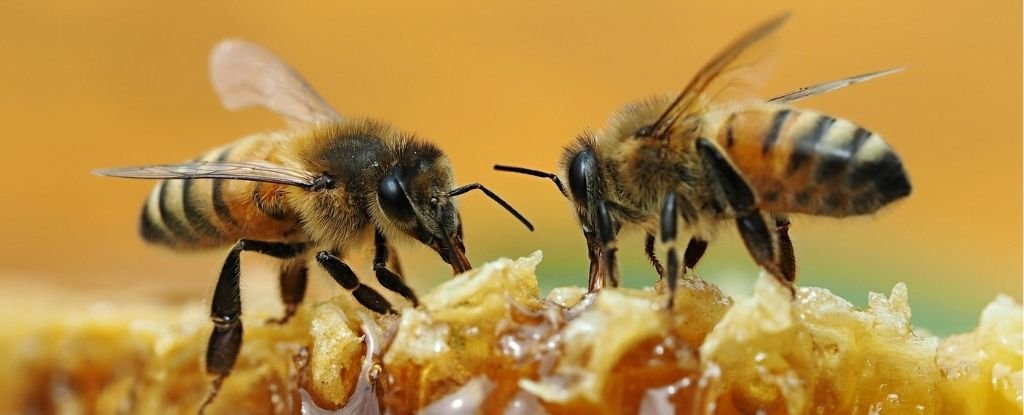Even though we all recognize bees for their importance in the food chain as pollinators, the crafty creatures have a series of other talents, including math ability, face recognition, and even tool use.
A 2021 video, originally posted on Twitter, showed a pair of bees apparently unscrewing the orange lid of a Fanta to reach the sugary liquid inside.
In today's age of digital trickery, we have to be mindful that this could just be clever CGI; or, perhaps the bees really did work together, and simply toppled an already loosely perched bottle cap.
Either way, it's fun to think about whether bees would have the brains to pull off such a soda heist.
According to ViralHog, the video licensor that acquired the footage, the moment was caught in São Paulo, Brazil by a worker on their lunch break.
"I got a soda from a customer but soon the bees stole it," the person wrote in the video's caption.
The smooth skill with which these two bees appear to twist the lid off a soda bottle baffled many on the internet, with some wondering how such intelligence exists in what is obviously a very tiny brain.
What kind of intelligence exists in such a tiny brain, how do they know it has to be twisted anti clockwise. ?
— Jeffrey Marlowe (@JeffreyMarlowe) May 25, 2021
I wouldn't have believed it if I didn't see it and I'm still not sure I believe it! 🤔
— Brian B. (@brian163t) May 25, 2021
As we've learned in recent years, however, the size of an animal's noggin isn't everything.
For one thing, tiny animals have far less body mass for brain cells to govern, so, naturally, they'll need smaller brains. In addition, the complexity of connections between neurons could be more important for cognitive performance.
In 1962, a decade before winning the Nobel Prize for research on bee communication, Karl von Frisch declared bumblebees too small-brained to think, putting their ingenious nature all down to hardwired instinct.
Since then, the question of just how much a bee's brain can manage has repeatedly been tested.
Despite having a noggin the size of a grass seed, roughly 0.0002 percent the size of our own, bees have proved surprisingly intelligent in recent research.
Not only these insects learn from each other and use tools, but they can also count to zero and perform basic mathematical equations.
The question is, how would a tiny seed-sized calculator turn its problem-solving skills to something as complex as removing a cap from a soda bottle?
Clearly, von Frisch's bias for large brains is still with us today. While the zoologist admitted bees could "accomplish astonishing intellectual feats", he claimed they did so only through instinct, failing "when suddenly faced with unfamiliar tasks".
Unscrewing the cap of a sugary drink is hardly a job bees evolved to tackle in nature, so von Frisch would be skeptical. It's possible the bees just got lucky this time, detecting a sweet reward that drove them to wander somewhat blindly against a slight resistance.
On the other hand, nature could yet surprise us. In the packed bee brain, for instance, a single nerve cell can sometimes contact up to 100,000 other cells.
This is amazing.
I forget where I read it, but I recently saw the question posed "can cells make decisions and change their minds".
The article related to amoeba behavior.
It is really profound to contemplate the origins and commonality of thought inherent in all life.
— Hvaldimir #StandWithUkraine #GuerrillaGardener (@Hvaldimir1) May 25, 2021
In a 2017 study, bumblebees were trained to roll a ball into a goal for a reward. To score, the insects needed to copy each others' movements and learn from their mistakes, which they were able to do with startling ease.
"Such 'tool use' at one time was ascribed to humans alone, but then to primates, next to marine mammals, and later to birds," researchers wrote in 2017.
"Now we recognize that many species have the capacity to envision how a particular object might be used to achieve an end."
Even with their small circuitry of neurons, bees may well be capable of far more than we once thought. Next time you treat yourself to an outdoor lunch, you might want to keep an eye on your drink.
A version of this article was first published in May 2021.






Recommended Comments
There are no comments to display.
Join the conversation
You can post now and register later. If you have an account, sign in now to post with your account.
Note: Your post will require moderator approval before it will be visible.